Fougasse with Olives is another one of the Mellow Bakers’ November breads. It is a dense, crusty French loaf with an unusual shape and a pronounced flavor.
I made the leaf version (without the olives) for my Dinner for 8 group this past weekend. We get together every month for dinner at someone’s house or a restaurant. This month, Sue hosted the dinner. She has a gorgeous house full of antiques.We thoroughly enjoyed going from room to room viewing all of her lovely collectibles and playing a fun game after dinner.
Originally, I was going to make rolls for the dinner, but I woke up early on Saturday and realized I had time to make the Fougasse. I thought it would make a lovely and festive addition to the table. It did! Everyone thought the shape was really unique and they kept asking me what it was called.
Everyone say it with me “fougasse!”
I like the shape and cuts of the Fougasse in the photo above, but I rolled the dough out too thin so it got a wee bit too crispy in places. I didn’t share this loaf with the dinner group. I’ve been enjoying it with a salad for lunch the past few days.
The loaf in the photo above is the one that came with me to the party. It looks a little pale in this photo, but it looked lovely on Sue’s counter before we ate it.
Recipe for Fougasse (without Olives)
Makes
: Two loaves
Adapted from Bread: A Baker’s Book of Techniques and Recipes by Jeffrey Hamelman
I omitted the olives and included some Herbes de Provence instead. I used a mixture of all-purpose and bread flour and a little bit of Kamut. It turned out to be a very light-colored bread. Perhaps next time, I’ll try it with bread flour and whole wheat flour to see the difference.
Ingredients:
Pâte Fermentée:
- 2.15 oz (1/2 cup) bread flour
- 2.15 oz (1/2 cup) all-purpose flour
- 2.8 oz (3/8 cup) water
- .09 oz (1/2 tsp) salt
- .002 oz, instant dry yeast (a small pinch)
Final Dough:
- 5.65 oz (2 1/8 cups) bread flour
- 5.65 oz (2 1/8 cups) all-purpose flour
- 1.7 oz (3/8 cup) Kamut (or whole wheat) flour
- 9 oz (1 1/8 cups) water
- .4 oz (2 tsp) salt (I didn’t add olives, so I increased the salt by 1 tsp)
- .05 oz (1/2 tsp) instant dry yeast
- 3 tsp Herbes de Provence
- .9 oz (2 T) extra-virgin olive oil
- Pâte Fermentée all of the above (7.2 oz)
Directions:
Making the Pâte Fermentée
Disperse the yeast in the water, add the flours and salt and stir until everything comes together and makes a coarse ball. Adjust the flour or water as necessary to ensure the dough is neither too sticky nor too stiff.
Transfer the dough to a counter sprinkled with flour. Knead the dough until it is soft and pliable, tacky but not sticky. About 4 to 6 minutes by hand or 4 minutes using the stand mixer.
Transfer the dough to a lightly oiled bowl and roll it around to coat it with the oil. Cover the bowl with plastic wrap and let it ferment at room temperature for two hours. You can use the preferment at this time or place it in the refrigerator for up to three days.
Mixing the Dough
Cut the Pâte Fermentée into about 10 small pieces with a pastry scraper.
Add all of the ingredients, except for the Pâte Fermentée and the olive oil, in the mixing bowl of your stand mixer. Using a spiral mixer, mix on first speed for 3 minutes in order to incorporate the ingredients. Add the Pâte Fermentée in chunks.
Adjust the hydration of the dough as necessary by adding additional flour or water. The dough should be medium consistency at this point. Drizzle in the olive oil. Mix on second speed for an additional 5 to 6 minutes until the dough has moderate gluten development. The desired dough temperature is 76 degrees F.
Bulk Fermentation
Let the dough ferment for 2 hours and fold the dough after 1 hour of bulk fermentation.
- To learn how to fold the dough, refer to the French Bread bloopers post.
- Or, use the Tartine Method of turning the dough in the bowl. I used the Tartine method for this dough.
Dividing and Shaping the Loaves
Divide the dough into 1-pound pieces. My pieces were slightly less than 1 pound since I didn’t include the 1/4 cup of olives.
Round the loaves lightly and place on a floured bench with the seams down. Cover with plastic and let them rest for about 20 minutes.
Final Fermentation
When the balls have relaxed sufficiently, use a rolling pin to flatten the dough into an oval shape.
Cover the ovals with plastic and let them proof for about an hour at 76 degrees F.
After the dough has risen, begin the final shaping. Preheat the oven to 450 degrees F with a baking stone on the middle shelf and a steam pan underneath.
Shaping the Fougasse Leaves
Pick up the dough and stretch it gently so that it is about half again as long as it was. Now, shape it into a long triangle with a base about half the length of the height. Using a pizza wheel or a paring knife, cut several diagonal slices into the dough. Stretch the dough some more, so the cuts are open. I tried doing this on the counter, but it lost its shape when I moved it so I put the ovals on parchment paper, then made the slices and it worked much better.
Baking the Loaves
Place the loaves (on the parchment paper) on the hot baking stone using a baker’s peel or the back of a baking sheet. Fill the steam pan with hot water and close the door of the oven. Spray the walls of the oven with a spray bottle filled with water about 3 times during the first few minutes. Reduce the oven temperature to 425 degrees F. Let the loaves bake for about 20 minutes until the loaves richly colored and crusty, but still have some give when squeezed. I didn’t bake my loaves quite that long because they were starting to burn in places. I took them out while they still had some “give” so they ended up being lighter in color.
By the time I transported the loaf to the dinner party, it had cooled off so it was a little chewy, not crispy, but the flavor was really good and I thought it went really well with the rest of the meal.
You might also enjoy rustic ladder-shaped fougasse.

Mellow Bakers was hosted by Paul at Yumarama. We baked breads from Bread: A Baker’s Book of Techniques and Recipes by Jeffrey Hamelman.
Happy Baking!
Cathy
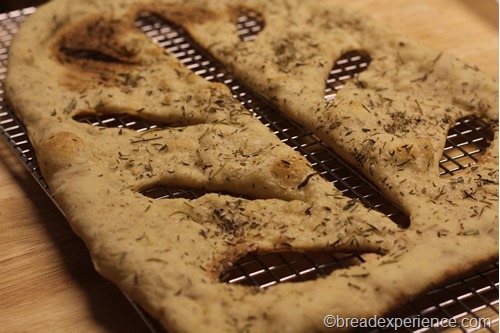
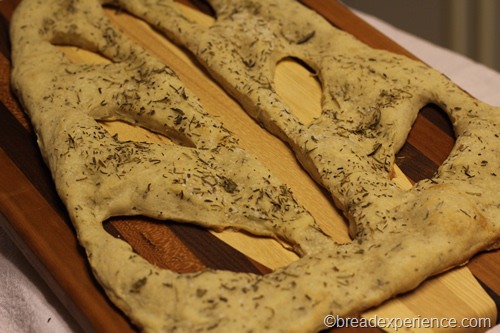
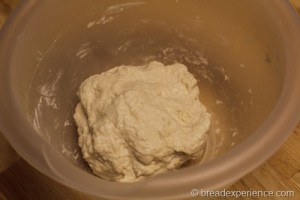
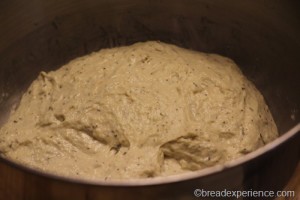
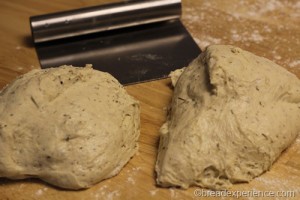
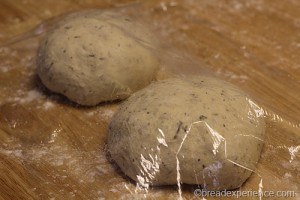
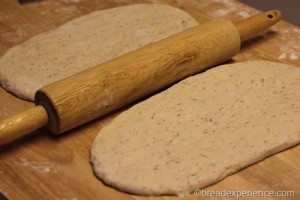
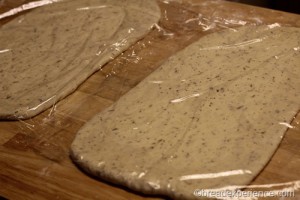
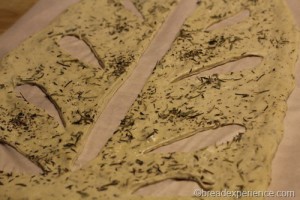
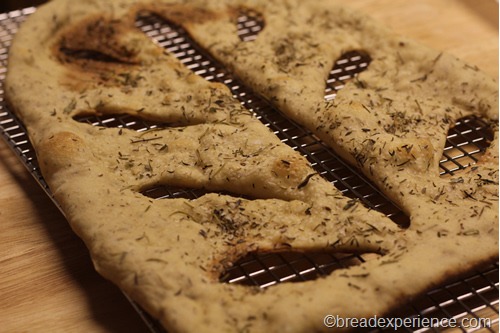
Melanie says
Looks wonderful!! I like the idea of Herbes de Provence and the omission of the olives. The herbs all over the surface looks really yummy. What a fun piece to bring to a dinner. I’ll bet that generated lots of questions/conversation.
kyleen says
Wow this looks delicious. I love the cutouts.
Cathy (breadexperience) says
Thanks! Yes, it did generate lots of conversation. I’ll definitely make this one again.
Pat says
Hi, I,m going to make this beautiful fougasse today. Waiting for the pate fermenter. I want to include the olives but at what point do I add them? Did I miss something. Thanks
Cathy says
Hi Pat,
I didn’t add olives to this bread so you’re not missing anything. You would add them after you add in the olive oil and have a moderate gluten development. Add the olives, then mix on 1st speed just until they are evenly incorporated. Then move on to the bulk fermentation.
I hope you enjoy the bread.
Happy Baking!
Cathy